Saturday, April 30, 2005
Photos of Unusual Things in Turkmenistan
This is a burning gas crater in the middle of the empty Kyzylkum desert. "The middle of the empty desert" isn't terribly descriptive, since the whole damn country is empty and the edges of the desert differ in no significant way from the middle. Anyway, this flaming crater is probably 100 meters across and about 20 meters deep. It is surely the entrance to hell.
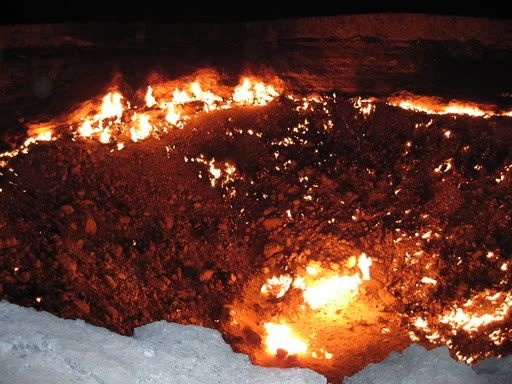
There are 25,000 Manat to the dollar (it seems to be the only currency which is NOT increasing in value against the dollar. The dollar has even slipped against the Azeri Manat). The biggest bill is a 10,000 -- not quite 50 cents. You have to carry wads and wads of cash with you and leave stacks to pay your restaurant bill. Turkmenistan is probably the cheapest country we've ever been to, though. Twenty dollars lasts several days.

And a lot of you are going to love this. This 15-liter top off at the TurkPetrol station set the driver back about 15 cents. Gas costs 300 Manat a liter. I'll do the math for you: Gas costs less than 5 cents a gallon. This proves that it's possible to have a bufoon for a president AND have cheap gas! You don't have to choose!

This dog is a special breed of hunting dog still used by the tribal nomads. It looks sort of like a small Afghan. Unlike Azeri dogs, which tend to be viscious, all the dogs we met in Turkmenistan were quite friendly, even the earless shepherds guarding the flocks.

Lenin lives! He still stands proudly in downtown Ashgabat, gesturing grandly east from a pedestal tiled in Turkmen carpet patterns. When the future is as bright as it is in Turkmenistan, there's no shame in the past!
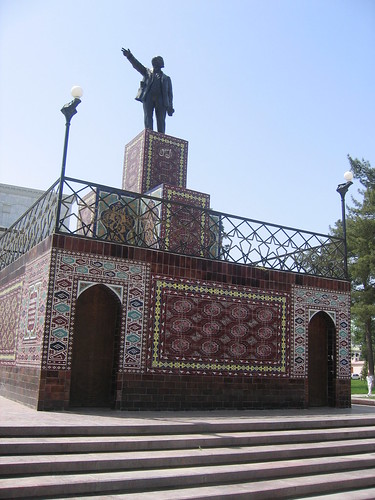
Pretty much everyone who doesn't live in an apartment block has one of these clay tandor ovens to make their bread. The woman heats it up in the morning. She flattens bread dough into discs, paints the bottom side with a salt water mixture, then sticks the dough disc to the inside walls of the hot tandor. The bread is really good when it's hot, but it gets hard really quickly. That's so it can be transported easily by nomads.
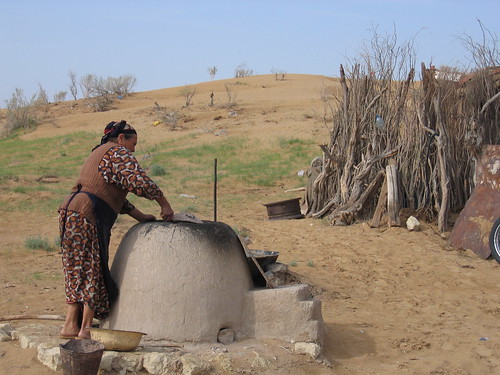

There are 25,000 Manat to the dollar (it seems to be the only currency which is NOT increasing in value against the dollar. The dollar has even slipped against the Azeri Manat). The biggest bill is a 10,000 -- not quite 50 cents. You have to carry wads and wads of cash with you and leave stacks to pay your restaurant bill. Turkmenistan is probably the cheapest country we've ever been to, though. Twenty dollars lasts several days.

And a lot of you are going to love this. This 15-liter top off at the TurkPetrol station set the driver back about 15 cents. Gas costs 300 Manat a liter. I'll do the math for you: Gas costs less than 5 cents a gallon. This proves that it's possible to have a bufoon for a president AND have cheap gas! You don't have to choose!

This dog is a special breed of hunting dog still used by the tribal nomads. It looks sort of like a small Afghan. Unlike Azeri dogs, which tend to be viscious, all the dogs we met in Turkmenistan were quite friendly, even the earless shepherds guarding the flocks.

Lenin lives! He still stands proudly in downtown Ashgabat, gesturing grandly east from a pedestal tiled in Turkmen carpet patterns. When the future is as bright as it is in Turkmenistan, there's no shame in the past!

Pretty much everyone who doesn't live in an apartment block has one of these clay tandor ovens to make their bread. The woman heats it up in the morning. She flattens bread dough into discs, paints the bottom side with a salt water mixture, then sticks the dough disc to the inside walls of the hot tandor. The bread is really good when it's hot, but it gets hard really quickly. That's so it can be transported easily by nomads.

WAZ vs. Neva
When you're out in the Middle of the Desert, you need a tough vehicle, maybe even two.
Nothing is tougher than the Russian-made WAZ jeep. It's completely stripped of luxuries that could break, like windows that roll down. Like my Neva, it's got a choke.
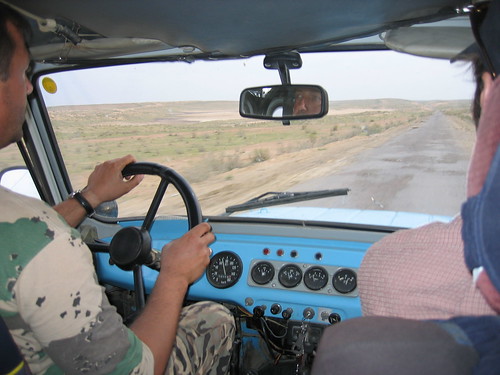
A very sophisticated dashboard
Our baby-blue WAZ climbed trackless sand dunes with considerable aplomb and hardly even creaked when landing back on the road after being launched airborne by a pothole. While it's true that the passenger seat became unwelded from its base after 3 days of lurching and bumping and crashing on desert tracks, that sort of thing is easily repaired once you get back to civilization.
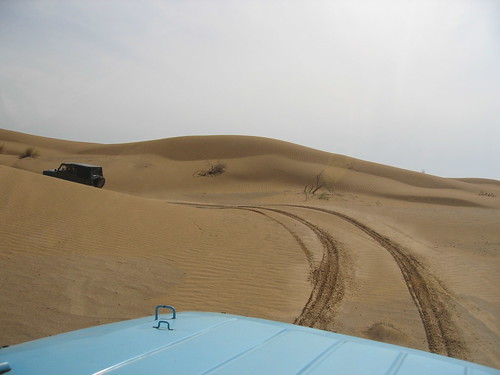
Where there is no road
For a lot of our exploring, we had two WAZs with us in case one went down. One characteristic that sometimes distinguishes the middle of the desert from its edges is the complete absence of anyone or anything that might be able to assist you when your car dies or gets stuck. It's best to bring two WAZs, just in case.

Stuck in a dune
While our driver/guide had considerable respect for a good Neva, he was a firm WAZ advocate for desert adventures in Turkmenistan.
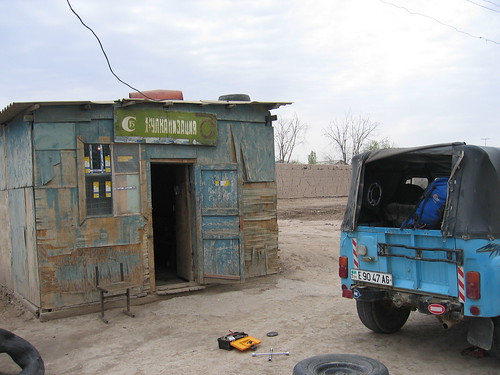
Sometimes even a WAZ has to stop at the mechanic's
Nothing is tougher than the Russian-made WAZ jeep. It's completely stripped of luxuries that could break, like windows that roll down. Like my Neva, it's got a choke.

A very sophisticated dashboard
Our baby-blue WAZ climbed trackless sand dunes with considerable aplomb and hardly even creaked when landing back on the road after being launched airborne by a pothole. While it's true that the passenger seat became unwelded from its base after 3 days of lurching and bumping and crashing on desert tracks, that sort of thing is easily repaired once you get back to civilization.

Where there is no road
For a lot of our exploring, we had two WAZs with us in case one went down. One characteristic that sometimes distinguishes the middle of the desert from its edges is the complete absence of anyone or anything that might be able to assist you when your car dies or gets stuck. It's best to bring two WAZs, just in case.

Stuck in a dune
While our driver/guide had considerable respect for a good Neva, he was a firm WAZ advocate for desert adventures in Turkmenistan.

Sometimes even a WAZ has to stop at the mechanic's
Floating Vomitorium
Sure, we had lots of WAZ adventures but the most colorful transport story comes from the ferry we took back to Baku. "Floating vomitorium" is a better description.
The former Soviet states serve as the red-headed stepchildren of the west. They get the hand-me-downs. When all your planes, boats and trucks fail to meet western environmental, efficiency or safety standards, where do you think they end up?
Our big, steel, corroding, smoke-belching hulk of a ferry transports rail cars between Turkmenbashi to Baku. It carried about 20 rail cars and had hundreds of cabins, all of which, except ours and the one next door, were empty of non-crew passengers.

Departing Turkmenbashi
In its past life, it provided service between Poland and Demark. We hoped "lack of seaworthiness" was not the reason it was demoted to duty on the Caspian.
"Schedule" in this part of the world is always loosely defined. Seeing the ferry at the terminal in Turkmenbashi when we pulled into town, our guide strongly suggested we go get on it, even though we hadn't planned to leave until the next day. There was no way to predict when the next one would show up and we had to be on one before our visas expired.
One of the dominant characteristics of the Caspian region, especially in spring, is the infernal wind. Weather delays in Baku and Turkmenbashi ports are very common.
A travel lesson we've learned -- but always seem to forget -- is to never ask, "how bad could it be?" Travel expands your imagination. I now know why it's not advisable to cross the Caspian in springtime and that, indeed, it can be pretty bad.
On board, we waited out one windstorm overnight in our tiny, dirty little cabin. We had been warned about the possibility of delay and the meager offerings in the ship's cafe, so we brought some food and water. We would have brought more had we known we'd have to share it with hordes of hungry ants.
Or that we'd be on board for 40 hours.
The whole issue of "what to eat" became moot about an hour after we left port.
"Boy, those waves are getting pretty big, aren't they?" I said to the Producer. He grunted without looking up from his book.
That was when things were relatively calm. Then wind and rain picked up.
This steel ship, carrying 20 rail cars, was being tossed around on the waves like a rowboat. It was too rough to read, play cards, walk, talk, or sit upright. It creaked and moaned every time it was slammed by a wave. An unlocked door in a vacant cabin banged against the wall with every rise and fall. Sterophonic retching from our neighbor's cabin passed through our walls.

See? This is a BIG ship
"We gotta get out of here."
We ran out into the maze of identical hallways, trying to find an exit to the deck where we could get fresh air. The shippy smell of diesel and grease was overpowering and repulsive, though I hadn't noticed it earlier and didn't notice it later.
We finally found a door: locked. Another door: locked. Apparently they don't want people being swept overboard in storms. Pondering briefly the safety implications of this policy, we ran back to our cabin and its hole-in-the-floor toilet.
Just in time too.
We spent the next 10 hours in a heap on the bed, rolling one way, then other, with the motion of the waves. Outside our porthole, which mercifully opened, the sea hissed and crashed.
Later, the "steward" knocked on the door to tell that while the ship had arrived in Baku harbor, we wouldn't be able to get off until the next morning.
In the cafe, we discussed the journey with our two fellow passengers over cherry juice and a bowl of tasty borsht. The middle-aged Azeri men worked for an American cargo company and make the trip frequently.
"This boat is old and terrible. That crossing was terrible. My friend was sick the whole time." He didn't need to tell us any of this, but we felt better, knowing that much more experienced hands were as debilitated as we were.
Later, I heard that my driver in Baku told my office manager, "they can't cross the Caspian. It's too windy." He didn't need to tell us that, but he was wrong.

Our sister ship, the Dagestan.
The former Soviet states serve as the red-headed stepchildren of the west. They get the hand-me-downs. When all your planes, boats and trucks fail to meet western environmental, efficiency or safety standards, where do you think they end up?
Our big, steel, corroding, smoke-belching hulk of a ferry transports rail cars between Turkmenbashi to Baku. It carried about 20 rail cars and had hundreds of cabins, all of which, except ours and the one next door, were empty of non-crew passengers.

Departing Turkmenbashi
In its past life, it provided service between Poland and Demark. We hoped "lack of seaworthiness" was not the reason it was demoted to duty on the Caspian.
"Schedule" in this part of the world is always loosely defined. Seeing the ferry at the terminal in Turkmenbashi when we pulled into town, our guide strongly suggested we go get on it, even though we hadn't planned to leave until the next day. There was no way to predict when the next one would show up and we had to be on one before our visas expired.
One of the dominant characteristics of the Caspian region, especially in spring, is the infernal wind. Weather delays in Baku and Turkmenbashi ports are very common.
A travel lesson we've learned -- but always seem to forget -- is to never ask, "how bad could it be?" Travel expands your imagination. I now know why it's not advisable to cross the Caspian in springtime and that, indeed, it can be pretty bad.
On board, we waited out one windstorm overnight in our tiny, dirty little cabin. We had been warned about the possibility of delay and the meager offerings in the ship's cafe, so we brought some food and water. We would have brought more had we known we'd have to share it with hordes of hungry ants.
Or that we'd be on board for 40 hours.
The whole issue of "what to eat" became moot about an hour after we left port.
"Boy, those waves are getting pretty big, aren't they?" I said to the Producer. He grunted without looking up from his book.
That was when things were relatively calm. Then wind and rain picked up.
This steel ship, carrying 20 rail cars, was being tossed around on the waves like a rowboat. It was too rough to read, play cards, walk, talk, or sit upright. It creaked and moaned every time it was slammed by a wave. An unlocked door in a vacant cabin banged against the wall with every rise and fall. Sterophonic retching from our neighbor's cabin passed through our walls.

See? This is a BIG ship
"We gotta get out of here."
We ran out into the maze of identical hallways, trying to find an exit to the deck where we could get fresh air. The shippy smell of diesel and grease was overpowering and repulsive, though I hadn't noticed it earlier and didn't notice it later.
We finally found a door: locked. Another door: locked. Apparently they don't want people being swept overboard in storms. Pondering briefly the safety implications of this policy, we ran back to our cabin and its hole-in-the-floor toilet.
Just in time too.
We spent the next 10 hours in a heap on the bed, rolling one way, then other, with the motion of the waves. Outside our porthole, which mercifully opened, the sea hissed and crashed.
Later, the "steward" knocked on the door to tell that while the ship had arrived in Baku harbor, we wouldn't be able to get off until the next morning.
In the cafe, we discussed the journey with our two fellow passengers over cherry juice and a bowl of tasty borsht. The middle-aged Azeri men worked for an American cargo company and make the trip frequently.
"This boat is old and terrible. That crossing was terrible. My friend was sick the whole time." He didn't need to tell us any of this, but we felt better, knowing that much more experienced hands were as debilitated as we were.
Later, I heard that my driver in Baku told my office manager, "they can't cross the Caspian. It's too windy." He didn't need to tell us that, but he was wrong.

Our sister ship, the Dagestan.
Sleeping on the Ground
Of 10 days in Turkmenistan, we only stayed three nights in a hotel. The rest of the time we stayed in nomad's yurts, private homes or in tents we brought with us. The reason for this is fairly practical: since Turkmen don't move around a lot and not many people visit, there aren't many hotels.
This is a chaykhana (teahouse)/truckstop/yurt that we stayed the first night while traveling on the main North/South road. There are only two main highways in the country. Calling this road a highway gives it far more credit than it deserves, since it is nothing more than craters connected by occasional chunks of asphalt. If it seems to be in "the middle of the desert" it's because it is.
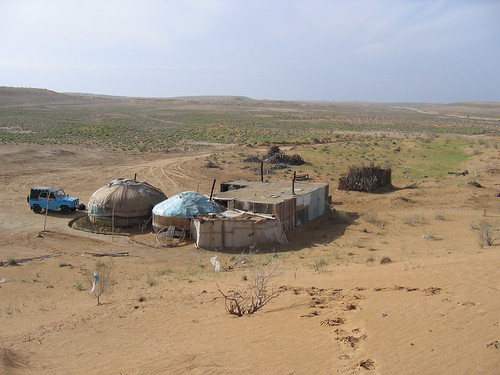
This is in the yurt of a Yomut nomad family we stayed with, uh, in a different part of the middle of the desert. The "grey beard" was a village elder and treated us like royalty. His yurt was incredibly luxurious, by local standards, and reflected his high standing in the village. The rugs and fittings on the floors and walls were astonishing. In fact, the camel bag behind the couple is the same as one I have at home! I had always known it to be a Yamut bag. Now I know exactly where it came from and the kind of people who made it! So cool!

I had breakfast with his wife and some of the other women. They cooked up some preserved meat (sort of like jerky stored in oil) seasoned with the shredded stalk of a garlicky-tasting desert plant that was in bloom and gave me some fermented camel's milk. We "talked" about the carpets and koches (felt pads) she makes and she offered me one as a gift. That wasn't really OK with me so we negotiated a price that included breakfast: $2. Her husband was deeply offended when he walked in and saw the transfer of funds because I was the guest. But then someone explained to him that we had negotiated it, and he was satisfied that his honor was still intact. Unfortunately the photos of her with the Koche are too blurry to post.
This is the roof opening of the yurt. It provides ventilation and lets the smoke out. The nomads build an open fire in the middle of the yurt which seems ill-advised considering it's made of felt and full of carpets, but it seems to work out fine.
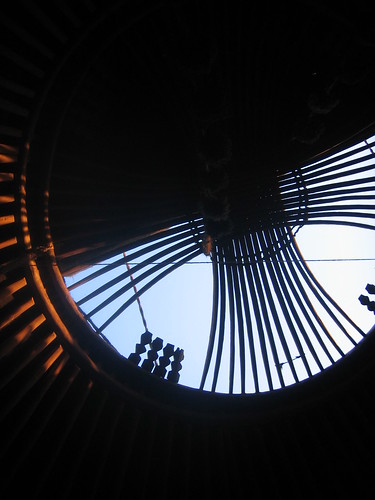
We spent a night in a village in the Kopet Dag mountains, which trace the Iranian border (the only time we were not "in the middle of the desert"). The insulated tribe that lives in this village has some fascinating, unique traditions. We stayed in the mountainside home of a lovely family and spent the evening eating plov and drinking vodka on this Koche-lined terrace. These are the various daughters and daughters-in-law who live there.
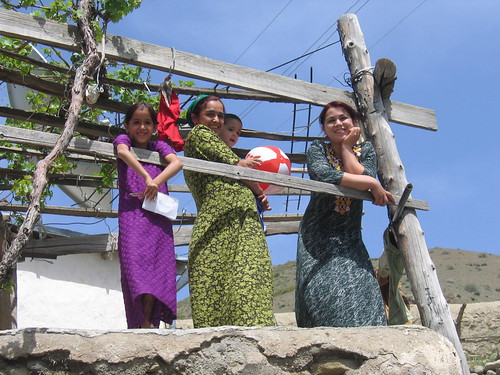
Distances between towns are vast and it's not smart to drive at night, so one evening we just pulled off the highway and drove off into the desert to camp for the night.

This place --Yangykala Canyon -- was stupendous. It's like Bryce Canyon, if Bryce Canyon was on the moon. The canyons were candy-cane striped from iron and completely, totally devoid of any sort of human influence.
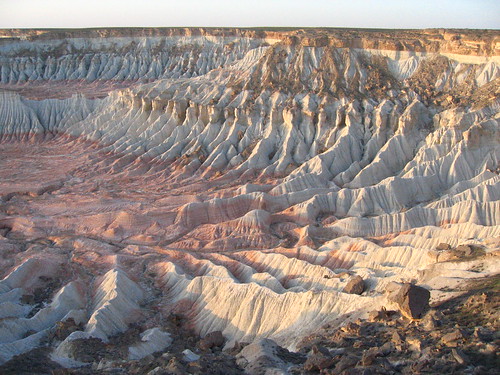
Of course people have been there before but there was no evidence of it and it felt like we were the only ones who had ever been there. This area, which is in the middle of the steppe (NOT the desert. There's a difference, but it's not apparent to the naked eye) was an ancient seabed and sea fossils were everywhere.
I don't know if there are degrees of remoteness, but every time I think we've really gone off the map, it seems like we end up in a place like this that makes all the other places seem like Grand Central. We camped right on the edge of the canyon. The full moon was spectacular.
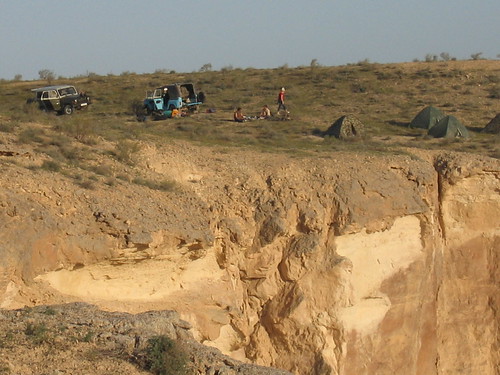
This is a chaykhana (teahouse)/truckstop/yurt that we stayed the first night while traveling on the main North/South road. There are only two main highways in the country. Calling this road a highway gives it far more credit than it deserves, since it is nothing more than craters connected by occasional chunks of asphalt. If it seems to be in "the middle of the desert" it's because it is.

This is in the yurt of a Yomut nomad family we stayed with, uh, in a different part of the middle of the desert. The "grey beard" was a village elder and treated us like royalty. His yurt was incredibly luxurious, by local standards, and reflected his high standing in the village. The rugs and fittings on the floors and walls were astonishing. In fact, the camel bag behind the couple is the same as one I have at home! I had always known it to be a Yamut bag. Now I know exactly where it came from and the kind of people who made it! So cool!

I had breakfast with his wife and some of the other women. They cooked up some preserved meat (sort of like jerky stored in oil) seasoned with the shredded stalk of a garlicky-tasting desert plant that was in bloom and gave me some fermented camel's milk. We "talked" about the carpets and koches (felt pads) she makes and she offered me one as a gift. That wasn't really OK with me so we negotiated a price that included breakfast: $2. Her husband was deeply offended when he walked in and saw the transfer of funds because I was the guest. But then someone explained to him that we had negotiated it, and he was satisfied that his honor was still intact. Unfortunately the photos of her with the Koche are too blurry to post.
This is the roof opening of the yurt. It provides ventilation and lets the smoke out. The nomads build an open fire in the middle of the yurt which seems ill-advised considering it's made of felt and full of carpets, but it seems to work out fine.

We spent a night in a village in the Kopet Dag mountains, which trace the Iranian border (the only time we were not "in the middle of the desert"). The insulated tribe that lives in this village has some fascinating, unique traditions. We stayed in the mountainside home of a lovely family and spent the evening eating plov and drinking vodka on this Koche-lined terrace. These are the various daughters and daughters-in-law who live there.

Distances between towns are vast and it's not smart to drive at night, so one evening we just pulled off the highway and drove off into the desert to camp for the night.

This place --Yangykala Canyon -- was stupendous. It's like Bryce Canyon, if Bryce Canyon was on the moon. The canyons were candy-cane striped from iron and completely, totally devoid of any sort of human influence.

Of course people have been there before but there was no evidence of it and it felt like we were the only ones who had ever been there. This area, which is in the middle of the steppe (NOT the desert. There's a difference, but it's not apparent to the naked eye) was an ancient seabed and sea fossils were everywhere.
I don't know if there are degrees of remoteness, but every time I think we've really gone off the map, it seems like we end up in a place like this that makes all the other places seem like Grand Central. We camped right on the edge of the canyon. The full moon was spectacular.

Carpetbanditry
The Turkmen have incredibly harsh restrictions about taking their carpets out of the country. If you're an ordinary mortal (not a diplomat), you can't take anything older than 30 years out. Indeed, you have to take every textile you buy to the museum and get a certificate verifying that it isn't old.
Don't even think of trying to be a carpetbandit. They check everything at the border.
It's really a shame, too. I saw some outstanding old stuff at the Tolkuchka Bazaar in Ashgabat -- the largest carpet market I've ever seen. So painfully, temptingly cheap, but there's no point in buying a gorgeous antique that you have to leave at the border. Unfortunately, I didn't see a lot of good-quality newer stuff. Most are factory made (by hand, still). They don't have a lot of character.
That doesn't mean you can't buy one. Two max, if one is small.
There are strict limits on how many you can take out: two square meters for one person, four square meters for a married couple. We had 3.98 square meters worth, but Turkmen are nothing if not sticklers for paperwork. "You have different last names. Show me your marriage certificate," demanded the examiner at the museum. When we told her we don't frequently carry such documentation with us, she told us we'd have trouble at customs. We held our breath at the port, but they didn't hassle us.

Our post-bazaar hotel room.
So, I ended up with a very traditional Tekke carpet (on the floor). Those are a dime a dozen in the country, but very expensive outside. It's of medium quality and lacking in a bit of character, but it's alright. I also got an interesting Yomut camel-hair prayer rug of much, much better quality, but it's got cotton weft, against which I have an unjustified bias. It's on the bed.
I also got a traditional felt pad called a Keche, but there's a good story behind it, so I'll post separately about it. It's on the bed by the Producer's legs.
Here's a nice link about Turkmen carpets.
Don't even think of trying to be a carpetbandit. They check everything at the border.
It's really a shame, too. I saw some outstanding old stuff at the Tolkuchka Bazaar in Ashgabat -- the largest carpet market I've ever seen. So painfully, temptingly cheap, but there's no point in buying a gorgeous antique that you have to leave at the border. Unfortunately, I didn't see a lot of good-quality newer stuff. Most are factory made (by hand, still). They don't have a lot of character.
That doesn't mean you can't buy one. Two max, if one is small.
There are strict limits on how many you can take out: two square meters for one person, four square meters for a married couple. We had 3.98 square meters worth, but Turkmen are nothing if not sticklers for paperwork. "You have different last names. Show me your marriage certificate," demanded the examiner at the museum. When we told her we don't frequently carry such documentation with us, she told us we'd have trouble at customs. We held our breath at the port, but they didn't hassle us.

Our post-bazaar hotel room.
So, I ended up with a very traditional Tekke carpet (on the floor). Those are a dime a dozen in the country, but very expensive outside. It's of medium quality and lacking in a bit of character, but it's alright. I also got an interesting Yomut camel-hair prayer rug of much, much better quality, but it's got cotton weft, against which I have an unjustified bias. It's on the bed.
I also got a traditional felt pad called a Keche, but there's a good story behind it, so I'll post separately about it. It's on the bed by the Producer's legs.
Here's a nice link about Turkmen carpets.
Sorry for the Silence!
We were in Turkmenistan for two weeks. It was an outstanding adventure and I do plan to post some reports and photos. It's just that the sun is out this weekend and all of Baku's other temptations are calling, so I'll get to it when I've exhausted all my other options.
Does anyone out there have a suggestion for a photo hosting site? I tried Hello! and didn't like it because I couldn't control how the pictures got posted--they went straight to the blog as a new post. The photos looked good once they were up though. I've been using Photobucket, which is pretty easy to use but the pre-set photo sizes are either too big and mess up the blog formatting, or too small and hard to see. I have some really great photos and while i can't do anything about the huge amount of time it takes to get them up with my crap dial-up, it would be nice if they looked good once they're up.
Does anyone out there have a suggestion for a photo hosting site? I tried Hello! and didn't like it because I couldn't control how the pictures got posted--they went straight to the blog as a new post. The photos looked good once they were up though. I've been using Photobucket, which is pretty easy to use but the pre-set photo sizes are either too big and mess up the blog formatting, or too small and hard to see. I have some really great photos and while i can't do anything about the huge amount of time it takes to get them up with my crap dial-up, it would be nice if they looked good once they're up.
Saturday, April 09, 2005
Imagine if you will
That you had pretty much decided that you weren't going to Turkmenistan for your vacation because the very hard-to-get visas hadn't come through (or, you came to your senses).
As an alternative, you decided to go to Barcelona, maybe Madrid and Bilbao. You were going to eat delightful tapas and drink rioja. You would stay in a 19th century hotel near the Ramblas. Maybe you'd go to the beach. You ordered your Rough Guides from Amazon and they had arrived.
Then, at 6:00 Friday afternoon, the day you were going to buy plane tickets to Barcelona, you get the word: Turkmenistan visas came through.
It's like you had planned to a trip to Hawaii, but got rerouted to Dallas. It's like, well, you'd planned a trip to Spain, but are going to Turkmenistan instead. It's a hard concept to get your head around.
We're going to fly into Tashkent, Uzbekistan (we laughed when we got 4 year multiple entry visas for our trip in 2003. "When will we ever go back to Uzbekistan?"). Cross the border and drive across the country over 10 days. Then, we'll take a "ferry" from Turkmenbashi across the Caspian back to Baku.
So instead of Gaudi's masterpieces, we'll see the central asian version of Las Vegas. Instead of Mediterranean beaches, we'll see a flaming sulfur crater in the middle of the desert. Instead of Picasso's Guernica, we'll see a 10 meter high gold statue of Turkmenbashi that rotates to follow the sun. Good times.
Initially, it was hard to abandon the idea Spain once it lodged in my brain. But when will I ever have the chance to see one of the world's most closed and bizarre societies at the height of its "glory?"
Spain isn't going anywhere.
As an alternative, you decided to go to Barcelona, maybe Madrid and Bilbao. You were going to eat delightful tapas and drink rioja. You would stay in a 19th century hotel near the Ramblas. Maybe you'd go to the beach. You ordered your Rough Guides from Amazon and they had arrived.
Then, at 6:00 Friday afternoon, the day you were going to buy plane tickets to Barcelona, you get the word: Turkmenistan visas came through.
It's like you had planned to a trip to Hawaii, but got rerouted to Dallas. It's like, well, you'd planned a trip to Spain, but are going to Turkmenistan instead. It's a hard concept to get your head around.
We're going to fly into Tashkent, Uzbekistan (we laughed when we got 4 year multiple entry visas for our trip in 2003. "When will we ever go back to Uzbekistan?"). Cross the border and drive across the country over 10 days. Then, we'll take a "ferry" from Turkmenbashi across the Caspian back to Baku.
So instead of Gaudi's masterpieces, we'll see the central asian version of Las Vegas. Instead of Mediterranean beaches, we'll see a flaming sulfur crater in the middle of the desert. Instead of Picasso's Guernica, we'll see a 10 meter high gold statue of Turkmenbashi that rotates to follow the sun. Good times.
Initially, it was hard to abandon the idea Spain once it lodged in my brain. But when will I ever have the chance to see one of the world's most closed and bizarre societies at the height of its "glory?"
Spain isn't going anywhere.
Sunday, April 03, 2005
Time For Rehab
Have a bad week? Go buy a carpet.
Have a good week? Go buy a carpet.
The Producer, who, for the first time made himself available for a Neva adventure, joined for a trip up to Guba on Saturday.
Guba is in the far north of the country, not far from the border with Russia/Dagestan. Although it's only about 2 1/2 hours drive from Baku, I had never visited it. As are most destinations in Azerbaijan, it's mildly interesting.
Unfortunately, we have been tricked several times into thinking it's spring. It snowed most of the day. It wasn't a good day for exploring.

A well-camouflaged Neva
Aside from the occasional Chechen and Dagestani, there are a number of ethnic groups that live near Guba. Although Azerbaijan is 95% Shi'ite, Jews have lived here for centuries without too many locally-caused problems. Indeed, right across the river from Guba lies Krasnaya Slovoboda, a tidy, prosperous-looking Jewish village with 5 or 6 operational synagogues. The area is also home to Lezghis, a Sunni sect whose brand of Islam incorporates even more animist traditions and who are known as fierce fighters.
Guba is also a traditional center for carpetmaking and locally made carpets have a distinctive pattern. We stopped by a women's collective that makes and sells carpets from their own workshop called Qadin Quba (Women Guba). They carpets are certainly nice and it was refreshing to see a women-run operation in Azerbaijan. While the new carpets didn't sing to me, they had a big pile of older Dagestani sumacs that called to me like a choir.
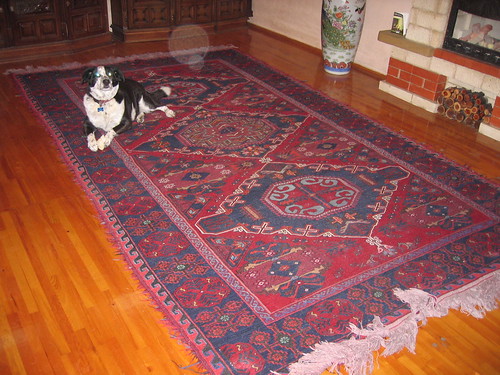
New carpets usually get Mo's approval
We really wanted to head up to the border with Dagestan to a town that reportedly has a carpet market. The weather was too awful though, so we only made it about half way before we turned around and headed back to Baku. There's no reason not to make another trip up there. The Neva has a lot of room.
Have a good week? Go buy a carpet.
The Producer, who, for the first time made himself available for a Neva adventure, joined for a trip up to Guba on Saturday.
Guba is in the far north of the country, not far from the border with Russia/Dagestan. Although it's only about 2 1/2 hours drive from Baku, I had never visited it. As are most destinations in Azerbaijan, it's mildly interesting.
Unfortunately, we have been tricked several times into thinking it's spring. It snowed most of the day. It wasn't a good day for exploring.

A well-camouflaged Neva
Aside from the occasional Chechen and Dagestani, there are a number of ethnic groups that live near Guba. Although Azerbaijan is 95% Shi'ite, Jews have lived here for centuries without too many locally-caused problems. Indeed, right across the river from Guba lies Krasnaya Slovoboda, a tidy, prosperous-looking Jewish village with 5 or 6 operational synagogues. The area is also home to Lezghis, a Sunni sect whose brand of Islam incorporates even more animist traditions and who are known as fierce fighters.
Guba is also a traditional center for carpetmaking and locally made carpets have a distinctive pattern. We stopped by a women's collective that makes and sells carpets from their own workshop called Qadin Quba (Women Guba). They carpets are certainly nice and it was refreshing to see a women-run operation in Azerbaijan. While the new carpets didn't sing to me, they had a big pile of older Dagestani sumacs that called to me like a choir.

New carpets usually get Mo's approval
We really wanted to head up to the border with Dagestan to a town that reportedly has a carpet market. The weather was too awful though, so we only made it about half way before we turned around and headed back to Baku. There's no reason not to make another trip up there. The Neva has a lot of room.



